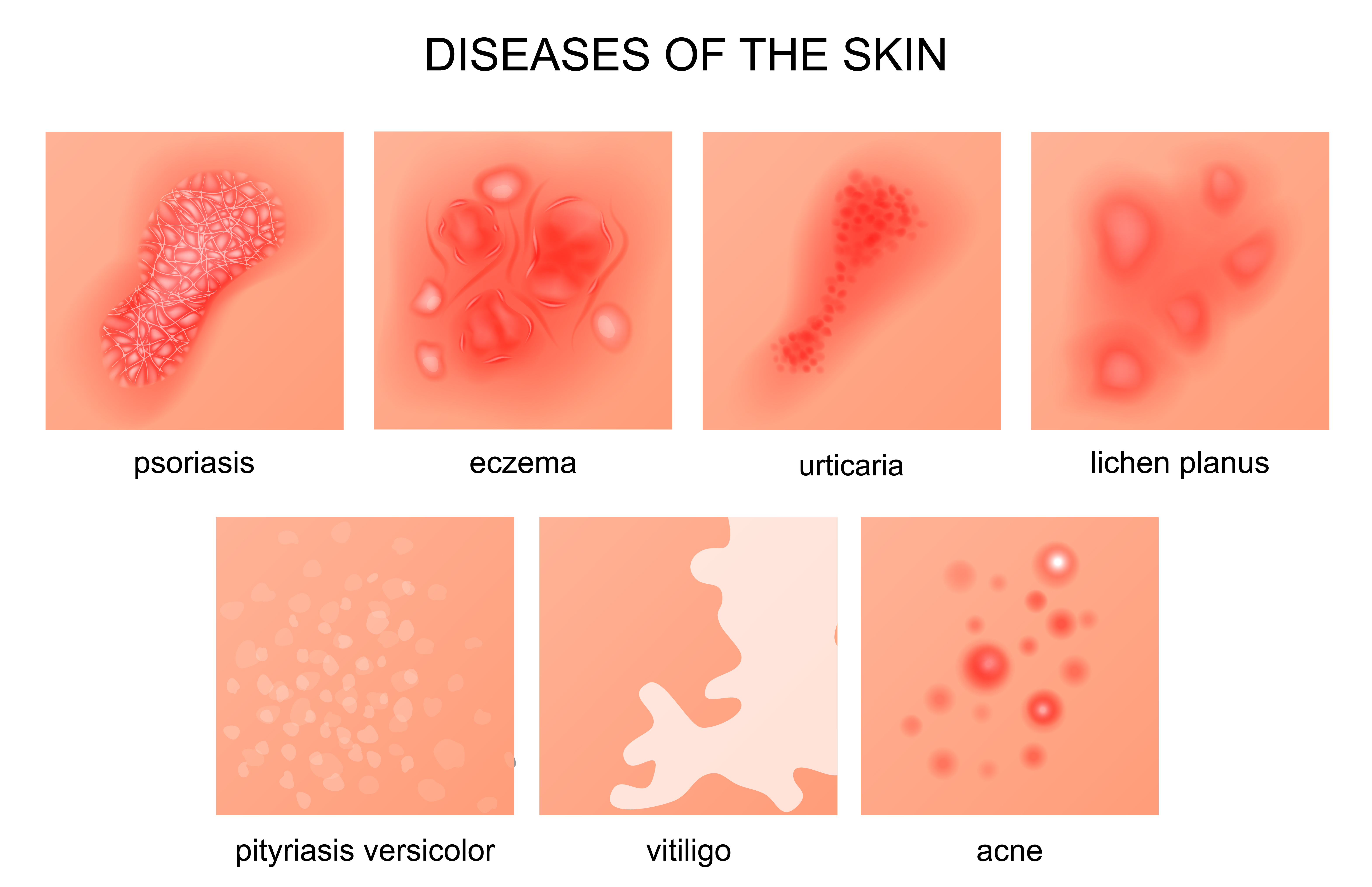Structure of skin
Our skin’s structure consists of several layers of different types of cells. The outer most layer exposed to the outside world is the epithelium which along with the next layer that contains some blood capillaries is known collectively as the epidermis. The epidermis is attached to the dermis via a very strong connection that resists shearing forces that might otherwise pull the layers apart.
The composition of the dermis is complex and diverse. Its strength is in the connective tissue that winds throughout this layer of our skin known as the extracellular matrix. It also contains blood vessels, nerves cells, lymphatic vessels, sweat glands, hair strands, sebaceous glands and muscle fibres. Adipose tissue along with hair follicles form part of the layer beneath the dermis.

Skins reflects our health and nutritional status
Our skin is the largest organ in the body and its essential to keep it healthy. Not only is it our first line of defence against foreign bodies and infections, it has many other functions not least making us aware of our environment through touch and pain for example. We must protect it from too much exposure to sunlight to prevent burning, but ensure enough sunlight hits the skin on a regular basis so that we can manufacture vitamin D. Vitamin D manufactured in the skin is the most efficient way of fulfilling our nutritional requirements for this vitamin, essential for healthy bones (by assisting in the absorption of calcium) and many other bodily functions, some just emerging due to extensive research.
Our skin also can reflect our health and nutritional status, quite obviously in some cases and can be very effective in ‘telling’ us when something is wrong. We see and feel when our skin is ‘not happy’. For example, some illnesses are shown in our skin, measles, chicken pox, Scarlett fever, meningitis, rubella to name but a few produce rashes on the skin and normally appear after a period of feeling unwell. We can diagnose certain illnesses by the rash they produce. However, these types of rashes cannot be prevented by eating a healthy diet, they are the result of a viral or bacterial infection. Normally we treat the rashes with creams, lotions or prescription tablets. But we can use our diet to help with the healing process.
Why diet is important for skin health
Healing is a very important aspect of keeping skin healthy and being nutritionally deficient can hinder this process. We not only need a healthy diet to support the immune system, we need it to help specifically with healing the skin when it might have been damaged not just by an infection but also by any type of wound. Our skin has the ability (like most other parts of our body) to regenerate and repair. Any person who has had a serious injury not only needs to repair wounds, but in general has an elevated metabolic rate, because their body is under stress. This means they have higher requirements for energy and nutrients, such as carbohydrates, lipids and proteins.

During skin wound regeneration, the connective tissue in the wounded skin needs to be re-built rapidly, this means protein synthesis is greatly increased. Any person who might be protein deficient from their diet, would compromise this process. Collagen a key constituent of the connective tissue, is particularly rich in certain amino acids glycine, lysine and proline, so they need to have a plentiful supply in the diet. Other proteins of the extracellular matrix are rich in the amino acids that contain sulfur (methionine and cysteine), so also required to be plentiful in the diet. The formation of collagen fibres, with their elastic and tensile properties, is dependent on a process that requires vitamin C. So a deficiency in this vitamin results in poor collagen formation. The skin becomes weak and has a tendency to bleed.
Foods rich in these amino acids include meat products in general, fish, beans and lentils, dairy products, eggs, nuts, seeds, cereal grains, red peppers, onions, broccoli. It’s essential that any individual and especially someone who is recovering from an injury to their skin has a diet rich in fruits, vegetables, protein (both meat and non-meat sources), dairy products, nuts, seeds and legumes.
Hydration!
It’s important to stay well hydrated as skin can show signs of dehydration very quickly, not only does our skin start to develop creases caused by dehydration but also biochemical reactions cannot take place as water plays a key role as a solvent for many biological reactions. Plain water is a great way to hydrate, but drinking black, green or white tea delivers flavonoids in the circulation as well.
Omega fatty acids
Essential fatty acids omega-3 and omega-6 are both important to keep skin healthy. An itchy, dry or scaly scalp could be a sign of omega-3 deficiency. These essential fatty acids cannot be manufactured in the body so have to be consumed in the diet, and they work in the body by supressing inflammation amongst other useful things. Omega-3 is best consumed from oily fish such as salmon, mackerel or sardines, but for vegetarians and vegan’s, consumption can also be via flaxseeds for example. Don’t overdose on fish oils though because there is evidence to suggest this can have a negative effect in the skin.
Iron
Iron deficiency can also lead to skin conditions, such as cracking at the corners of the mouth, or pale looking skin. The best dietary source of iron, known as heme iron is red meat, however vegetarians can get iron from dairy products and vegans from legumes, whole grains, green leafy vegetables, dried apricots and figs for example. Always remember to consume iron rich foods with a source of vitamin C – fresh vegetables and fruit especially citrus fruits and kiwi fruit, and avoid tea and coffee shortly before or after eating an iron rich meal, as these will prevent iron absorption in the gut.
Vitamins
B vitamins are also important for healthy skin as a deficiency can cause itchy, dry skin. A good dietary source of B vitamins are whole grains. So try to swap that white bread for wholegrain bread, same goes for rice and pasta! The antioxidant properties of vitamin C, E and beta-carotene help protect skin from sunburn and improve its resilience to irritants. Olive oil is a great source of vitamin E, so add it with a little balsamic vinegar to a fresh made green salad to accompany your lunch time or evening meals. Beta-carotene converts to vitamin A in the body and can be obtained from eating richly coloured fruit and vegetables such as carrots, pumpkin, mango, paw paw and spinach. Roasting tomatoes makes the lycopene in the tomato skin more bioavailable and combined with other carotenoids boosts their skin protecting qualities against sunburn.
Benefits of supplements
Some supplements on the market show they contain biotin – vitamin B7, to help with keeping skin healthy. So far there is little evidence to suggest that biotin has a role to play in skin health directly, however it is important for fatty acid synthesis which is important for skin health. Supplements also can contain lutein, this antioxidant increases skins hydration and elasticity as well as protecting the skin from harmful UV rays. The best source of dietary lutein is cooked spinach, but it’s also present in kiwi fruit, courgette and different types of squash for example.
Co-enzyme Q10 may also appear on the label of supplements for skin health. This powerful antioxidant helps neutralise free radicals responsible for damage to collagen and elastin in the skin, especially in aging skin, but can also be found in offal, red and white meat, fatty fish, vegetables (e.g. spinach, broccoli), fruit (e.g. oranges and strawberries), legumes, nuts and seeds. There is evidence to suggest supplements of co-enzyme Q10 is as well absorbed as dietary sources of this nutrient.
Collagen supplements are also popular for skin health, although the body makes collagen all the time, as we age this process becomes less efficient. There is some evidence to suggest that collagen supplementation helps improve skin elasticity and hydration, but more research is needed.
A healthy balanced diet rich in wholegrains, vegetables and fruit, lean animal or plant based protein, oily fish (once a week), as well as nuts, seeds and plant based oils should be sufficient along with drinking plenty of water to keep our skin healthy and able to fight infections and heal wounds. But it could be argued that there is some room for supplementation when it comes to slowing the aging process of skin






